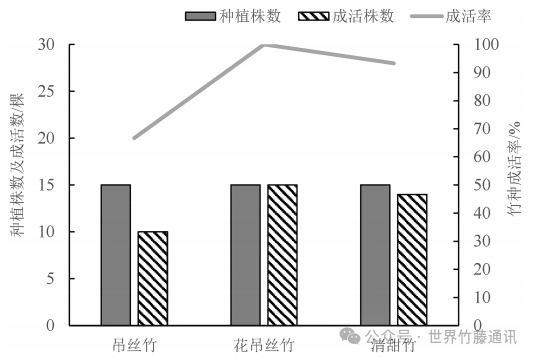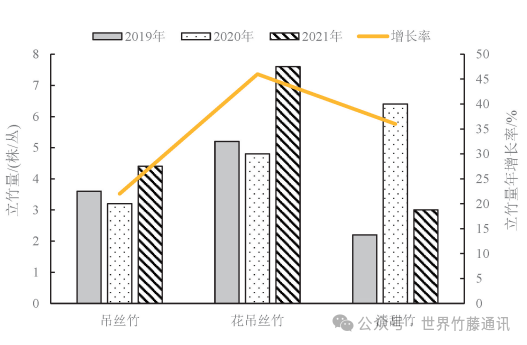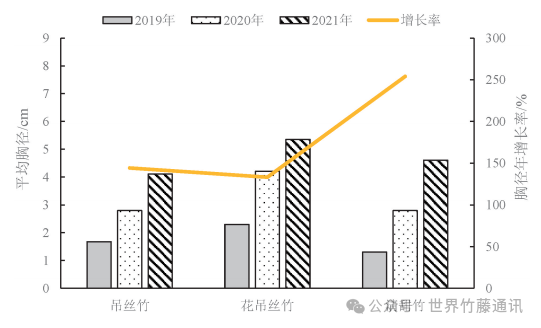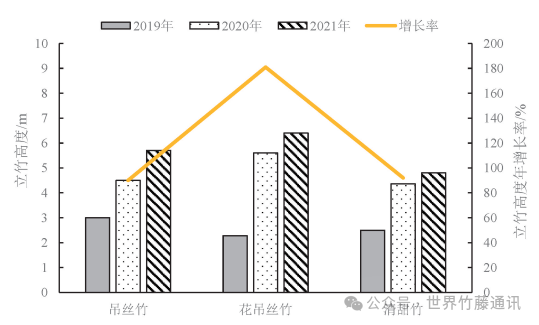Agricultural plastic film | Environmentally friendly degradable film | Self adhesive protective film
Conductive film | High barrier cling film | Heat shrink film
Welcome to Changzhou Hefeng Packaging Materials Co., Ltd!
Agricultural plastic film | Environmentally friendly degradable film | Self adhesive protective film
Conductive film | High barrier cling film | Heat shrink film
In order to screen excellent bamboo species suitable for promotion and planting in northern Guangxi, the growth adaptability of three medium-sized bamboo species in the genus Dendrocalamus Sapidus, D. minor var. amoenus, and D. minor was compared and analyzed for three consecutive years. The results showed that all three bamboo species exhibited good adaptability to the natural environmental conditions in northern Guangxi. Among them, Qingtian bamboo, as a local bamboo species, has a large number of new bamboo shoots every year and a fast growth rate, making it suitable for large-scale promotion and planting. Based on various growth indicators, the adaptability of the three bamboo species in the northern region of Guangxi is as follows: Sweet bamboo>Flower hanging silk bamboo>Hanging silk bamboo.
Dendrocalamus minor, Dendrocalamus minor var. amoenus, and Dendrocalamus sapidus are medium-sized bamboo species in the genus Phyllostachys. Among them, the hanging silk bamboo, also known as the Wuyao bamboo, is a tropical and subtropical positive bamboo species. It is naturally distributed in Guangxi, Guangdong, Guizhou and other places, and has been introduced and cultivated in Yunnan, Zhejiang, Fujian and other places. In Guangxi, the western and southwestern rocky mountain areas are the main cultivation areas. Hanging bamboo has high fiber content, thick bamboo walls, and good bamboo properties. Its main business purpose is for material use, and it also has functions such as papermaking, food, landscape, and ecological greening. Flower hanging silk bamboo is a variant of hanging silk bamboo, often mixed in hanging silk bamboo forests. The bamboo stem is light yellow with dark green vertical stripes. The bamboo stem is uniform in size, and the bamboo clusters are compact and beautiful. It is often used for park and courtyard greening. It is a common bamboo species in hilly and limestone mountainous areas of Guangxi and Guangdong. Qingtian bamboo is similar to hanging silk bamboo, but each section of the bamboo stem has buds, low branching, white thorns on the internodes, and the back of the sheath is densely covered with brown thorns. It is a high-yield and high-quality papermaking material.
In recent years, governments at all levels in Guangxi have attached great importance to the development of the bamboo industry, and the area of bamboo forests has continued to expand. The bamboo industry has become a key industry supporting local economic and social development. In order to enrich the variety of afforestation bamboo species in northern Guangxi, promote the planting of excellent bamboo species, and increase the area of bamboo forests, this study compared and analyzed the growth adaptability of medium-sized bamboo species in the genus Phyllostachys, including Qingtian bamboo, Huadiaosi bamboo, and diaosi bamboo, for three consecutive years, in order to screen out excellent bamboo species that are suitable for the natural conditions in northern Guangxi.
1 Materials and Methods
1.1 Overview of the experimental site
The experimental site is located in the bamboo garden of Liuzhou Forestry Science Research Institute. The location is north of the Tropic of Cancer, with a geographic position of 109 ° 17 ′ 56 ″ E and 25 ° 6 ′ 24 ″ N, and an altitude of 111 meters. It belongs to a typical subtropical monsoon climate, with mild climate and abundant rainfall throughout the year, but uneven distribution. It is dry and rainy in spring and autumn, humid and rainy in summer, and dry and cold in winter. The average temperature over the years is 19.9 ℃, with the coldest month having an average temperature of 9.1 ℃, the absolute lowest temperature being -1.2 ℃, and the hottest month having an average temperature of 28.3 ℃. The extreme highest temperature over the years is 38.9 ℃, and the extreme lowest temperature over the years is -1.0 ℃. The annual average rainfall is 1841.5 mm, with 1330.7 mm from April to August, accounting for 73% of the total annual rainfall. The annual average relative humidity is 77%, with a minimum relative humidity of 13%. The annual average frost free period is 359.8 days. The annual sunshine duration is 1329.9 hours, accounting for 30% of the available sunshine hours. The annual average wind speed is 1.7 m/s, and the maximum wind direction is northeast wind. The annual average evaporation is 1320.5 mm, and the annual thunderstorm days are 59.3 days. The main meteorological disasters include rainstorm, flood, low temperature rain, high temperature drought, thunderstorm, cold wave, frost, etc. The soil is mainly red soil and yellow soil, and the soil in arid areas is mostly mountainous red soil with red brown soil and sand shale development.
1.2 Experimental bamboo species and experimental design
The experimental bamboo species are medium-sized bamboo species in the genus Phyllostachys, including sweet bamboo, hanging bamboo, and flower hanging bamboo. Sweet bamboo mother bamboo comes from Liuzhou City, while hanging silk bamboo and flower hanging silk bamboo mother bamboo come from Nanning City. Bamboo planting was carried out in March 2019 using a randomized block experimental design, with a planting area of 667 m2 for each bamboo species and a row spacing of 4 m × 4 m. Three replicates were set up, with five plants per replicate.
Before planting, prepare the soil, remove weeds and debris from the experimental site, and loosen the soil by 20-30 cm. The soil in the experimental site is mountainous red soil, which, although relatively fertile, is affected by leaching. Elements such as potassium, calcium, and sodium accumulate less in the soil, while iron and aluminum content is higher. Therefore, potassium fertilizer and organic fertilizer should be applied to improve soil structure and enhance soil biochemical activity. According to the root system of bamboo seedlings, dig holes and plant them with a diameter of 40-60 cm and a depth of 40-50cm. Apply organic fertilizer about 8 cm thick at the bottom of the hole, cover it with soil for 5 cm, and then plant and fill it with soil. After planting, apply organic fertilizer and compound fertilizer once a year in spring, and promptly prune diseased branches and dead branches; Strengthen the cleaning and inspection monitoring of weeds, dead branches and leaves at the roots of bamboo groves, maintain ventilation, and reduce the growth of pests, diseases and bacteria. Conduct weeding and nurturing twice a year to observe the growth performance of different bamboo species under natural conditions in northern Guangxi.
1.3 Survey Indicators and Data Analysis
From the year of planting (2019) to December 2021, a survey was conducted on the growth of bamboo clusters for three bamboo species. The survey indicators included survival rate of bamboo species, number of standing bamboo per cluster, average diameter at breast height of standing bamboo, and average height of standing bamboo. The data was analyzed using WPS software to compare the growth differences among three bamboo species.
2 Results and Analysis
2.1 Survival rate of bamboo species
In 2019, investigate the survival rate of each bamboo species after planting and leafing. The survey and statistical results are shown in Figure 1. It can be seen that all three bamboo species can adapt well to the climate and environment of the experimental site, among which the survival rate of bamboo clusters is higher for the flower hanging silk bamboo and the sweet bamboo. The survival rate of the three bamboo species is as follows: Flower hanging silk bamboo (100%)>Sweet bamboo (93.3%)>Hanging silk bamboo (66.7%).

2.2 Bamboo species and standing bamboo quantity
The amount of standing bamboo is influenced by various factors, such as soil fertility, water conditions, light intensity, pests and diseases, and human management measures. The amount of standing bamboo varies among different bamboo species due to their growth characteristics, environmental conditions, and management methods. The survey and statistical results (Figure 2) show that compared with 2019, in 2020, due to the influence of climate and pests and diseases in the experimental area, the number of standing bamboo plants of Phyllostachys edulis decreased from 3.6 plants/clump to 3.2 plants/clump, and the number of standing bamboo plants of Phyllostachys edulis decreased from 5.2 plants/clump to 4.8 plants/clump, with a decreasing growth rate of 11% and 8% respectively; However, during the same period, the standing bamboo quantity of Qingtian bamboo increased from 2.2 plants/clump to 6.4 plants/clump, an increase of 191%. By 2021, the number of standing bamboo plants of Phyllostachys edulis and Phyllostachys edulis has increased by 1.2 and 2.8 plants/clump, respectively, with an increase of 38% and 58% compared to 2020, while the number of standing bamboo plants of Phyllostachys edulis and Phyllostachys edulis has decreased by 3.4 plants/clump, with a decrease of 53%. Overall, the productivity and health status of the three bamboo species were good from 2019 to 2021.

2.3 Bamboo diameter at breast height
The increase in breast height diameter of bamboo plants is closely related to their growth environment. The survey and statistical results (Figure 3) show that the average breast height diameter of the three bamboo species has been increasing year by year over the past three years. Among them, the average diameter at breast height of Qingtian bamboo increased from 1.3 cm in 2019 to 4.6 cm in 2021, with the fastest growth rate of adult bamboo diameter at 254%; The hanging bamboo increased from 1.68 cm in 2019 to 4.1 cm in 2021, while the flowering hanging bamboo increased from 2.3 cm in 2019 to 5.35 cm in 2021. This indicates that the three bamboo species have a certain tolerance to the barren mountain red soil developed by sand shale in northern Guangxi and can grow normally. Among them, the sweet bamboo has the best breast diameter growth performance, followed by hanging bamboo and flowering hanging bamboo.

2.3 Bamboo planting height
The standing height of bamboo is one of the important indicators of bamboo growth, including the natural drooping parts of bamboo stems and stems. During the experiment, three bamboo species were affected by monsoon climate and pests and diseases, resulting in the breakage of bamboo stalks. Among them, 12 bamboo stalks were broken, 7 bamboo stalks were broken, and 6 bamboo stalks were broken, which affected the height measurement of the bamboo species. The investigation found that among the three bamboo species, except for a few plants that showed breakage, all other individuals were able to grow normally. The height growth of bamboo between bamboo species is influenced by various factors such as season, soil conditions, and their own biological characteristics, showing different patterns of change. The statistical results show (Figure 4) that the average standing height growth of the bamboo species, Phyllostachys edulis, performed the best, increasing from 2.28 m in 2019 to 6.4 m in 2021, an increase of 181%. The height growth of the other two bamboo species was slower, while that of the sweet bamboo species increased from 2.5 m in 2019 to 4.8 m in 2021, an increase of 92%; Hanging bamboo has grown from 3 meters in 2019 to 5.7 meters in 2021, an increase of 90%.

3 Discussion and Conclusion
The climate types in the northern region of Guangxi are diverse, belonging to subtropical climate, with abundant rainfall and heat resources. At the same time, catastrophic weather events occur frequently. Different bamboo species have different requirements and adaptability to climate, environment, soil, and other factors. This experiment preliminarily explored the early adaptability of three medium-sized bamboo species in the genus Phyllostachys planted in northern Guangxi, without considering the effects of soil microorganisms, pests and diseases, harsh climate, and management measures on the growth of bamboo species. With the gradual deepening of the introduction experiment, research will be conducted on the effects of various environmental factors and management measures on the growth and development of various bamboo species, in order to provide support for the selection of excellent bamboo species, efficient management of bamboo forests, and sustainable development of the bamboo industry in northern Guangxi.
The results of this study showed that three medium-sized bamboo species in the genus Phyllostachys, including Phyllostachys edulis, Phyllostachys edulis, and Phyllostachys edulis, all exhibited good adaptability to the natural environmental conditions in northern Guangxi. Among them, Phyllostachys edulis, as a local bamboo species, has a large number of new bamboo shoots every year and a fast growth rate, making it suitable for large-scale promotion and planting. Phyllostachys edulis showed the second best performance, while Phyllostachys edulis had relatively poor growth performance. Whether it is suitable for promotion and planting in northern Guangxi needs further observation and research.
Welcome to Changzhou Hefeng Packaging Materials Co., Ltd!
Mobile phone: 15895061333
Email: 115555372@qq.com
Address: Moujia Village, Zhenglu Town, Tianning District, Changzhou City
Copyright © 2025 Changzhou Hefeng Packaging Materials Co., Ltd